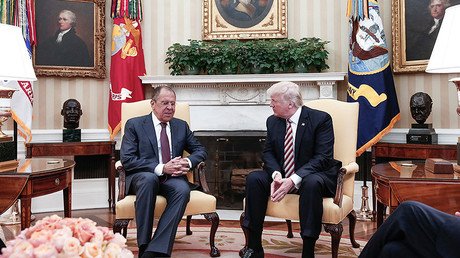‘US media fuss about Russian ambassador at Trump-Lavrov meeting is much ado about nothing’
The US media outcry about TASS photos from the Trump-Lavrov meeting is "much ado about nothing." It is normal for the ambassador to meet with the president, particularly if he is accompanying the foreign minister, experts told RT.
After American President Donald Trump's first face-to-face meeting with Russian Foreign Minister Sergey Lavrov had been held behind closed doors at the White House on Wednesday, the US media was worked up about the presence of a Russian photographer. The US media took that as an affront.
Each side had a personal photographer: Aleksandr Shcherbak together with an American photojournalist was in the Oval Office ahead of the meeting.
The photos from the meeting revealed the Russian ambassador to the US Sergey Kislyak also participated in the talks. That led to more furor in the media with some dubbing the Russian ambassador a top spy and speculated whether the Oval Office had been bugged.
"They made it sound like [TASS photographer story] was the most nefarious thing that's ever happened. “There was a TASS photographer who was let in, and no one from the US or the Western media were allowed.” I don't want to use the phrase ‘much ado about nothing.' But look at these pictures. So what? This photographer was checked, vetted, sniffed, scanned. Have you been to the White House? They check everything about you. He was actually told, “All right, move in here, take this picture.” Whether he works for specifically TASS itself or the foreign ministry, he said here's the picture; you can put a copyright on the picture. That's it. I'm moving on, no big deal. I can't find where the story is with this. They took the picture, and they published it. What if there were no pictures, if it was a secret meeting, no recording of this, now that might have been something," media analyst Lionel told RT.
'Urge US journalists not to pin blame on others for their failure' - Russian photographer who filmed Lavrov & Trump https://t.co/P16HmXZVt0
— RT (@RT_com) 12 мая 2017 г.
RT: Rex Tillerson and Sergey Lavrov had their meeting on the books for quite some time. What do you think was the purpose of President Donald Trump also meeting the Russian Foreign Minister?
Michael Maloof, former Pentagon official: Lavrov and Tillerson met at the State Department and then went over to the White House. I think it was a reciprocal arrangement, pretty much what Tillerson did when he was in Moscow: first meeting with Lavrov and then with President Putin for two hours. So I think that this was a reciprocal thing. I think it was also a signal that President Trump feels that with Russia there's so many other issues on the table that need to be worked out, that it cannot be done without working with the Russians - whether it's Syria, North Korea, Yemen, you go right down the line. And up until now his main advisors, mostly the establishment types, the neocons such as McMaster and James Mattis have offered no solution except war.
RT: These are these are lifetime career military men…
MM: They're not strategic thinkers. And even though they can think militarily in terms of strategic terms, but not diplomatic.
RT: That's an important distinction. The two foreign ministers were expected to discuss the so-called de-escalation zones that are being established now in Syria. The US is not a party to the development of these zones because it was just the three power brokers in the region: Turkey, Iran, and Russia. Do you think the US is ready to assist in these zones or might that somehow interfere with the Trump administration, like McMaster - they're seemingly flip-flopping goal of removing Assad from office…
MM: I think what we heard from President Trump was that he agreed with Foreign Minister Lavrov in terms of de-escalation zones that he wants to be involved and participate in that, you saw in the after brief that Mr. Lavrov was quite pleased with their discussion. So it's a signal that the United States is going to agree to them, then to recognize them and to work with the Russians in coordination toward a solution on Syria.
RT: Has a de-escalation zone ever been attempted in war-torn regions and if so, have they been successful?
MM: No, they have not really been. You've had some temporary safe zones very early on with Turkey when the crisis between Turkey and Syria first arose, in which refugees would flow into that, but that became awash. No free zones have ever worked out. What you need is enforcement. This is going to be the issue with the de-escalation: how do you enforce it, how do you monitor it and how do you make sure it works in terms of time to create the conditions for ceasefire toward negotiations.
RT: Another surprise show at the White House was Russian Ambassador Kislyak, who as we know has been under the microscope due to his meetings with Michael Flynn. Is that common for ambassadors to meet with US presidents under these circumstances and further do you think it was wise for President Trump to do all this amid this Russian hysteria?
MM: It's normal for the ambassador to meet with the president, particularly if he's accompanying the foreign minister. Mr. Trump didn't seem to care about whether or not he was meeting with the Russian ambassador. This is a man who says “I'll do it my way” and he's doing it his way. Notwithstanding the politics.
The statements, views and opinions expressed in this column are solely those of the author and do not necessarily represent those of RT.












